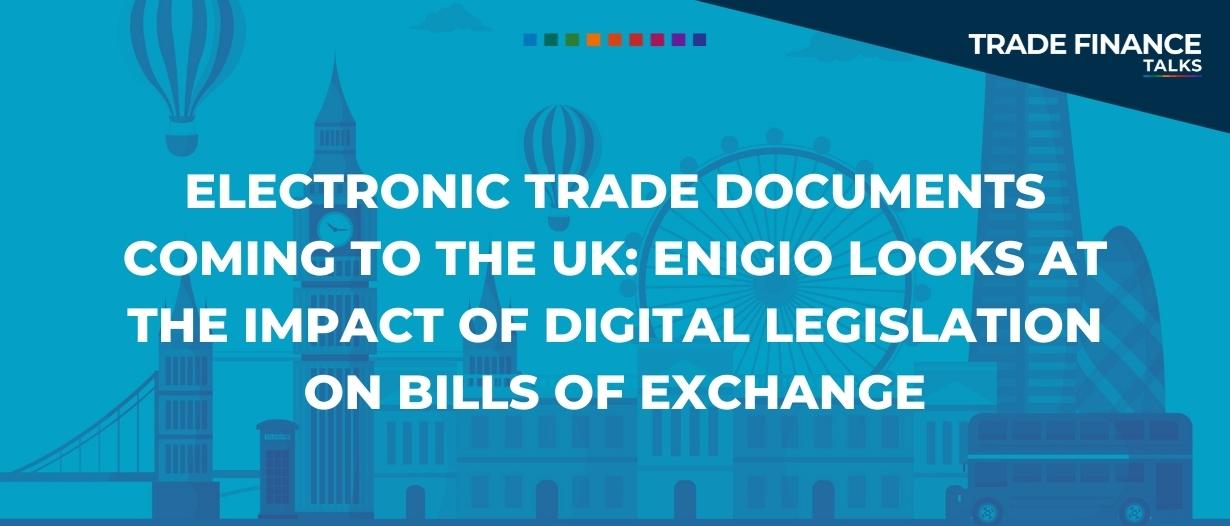Estimated reading time: 5 minutes
During the Queen’s Speech on 10 May 2022, Prince Charles, standing in for the Queen, announced the Electronic Trade Documents Bill among the list of legislation that the Government intends to pursue in the upcoming parliamentary session.
The Electronic Trade Documents Bill will enable greater digitisation of trade-related paperwork and is expected to be based on the UN model law for electronic transferable records (MLETR).
This is a hopeful sign for the future of digital trade in the UK and will hopefully lead to many more jurisdictions around the world following the British lead and prioritizing similar legislations.
Currently, Singapore, Abu Dhabi, and Bahrain are the only jurisdictions to have adopted MLETR into national law.
To better understand the impact that this seemingly innocuous announcement will have on the industry, consider the example of a bill of exchange.
A digital bill of exchange
The bill of exchange is an excellent record of debt – one simple document that is recognised globally and convenient for all parties.
For those who are not convinced about their usefulness remember that they have been around for more than a thousand years and are legal documents that are easily enforceable in practically all countries.
It is an unconditional, irrevocable, stand-alone payment undertaking that is separate from, and independent of the underlying contract to which it relates.
Bills of exchange are also freely negotiable instruments that can easily be sold and traded in the secondary market.
They mitigate and manage many risks compared to open account transactions and they are easy to create using a printer, a piece of paper, and a pen for signing.
In addition to all this, there are no restrictive or onerous requirements on any counterparty impacting their ability to receive, manage, sign, or send a paper bill of exchange.

But nobody likes to use paper anymore
Bills of exchange tend to be underused and the main reason is that they are predominately paper-based.
This means they must be physically managed and signed in wet ink by all parties in a transaction and they have to be physically delivered by mail or courier.
They can also be misplaced and are easily forged or fraudulently amended.
Furthermore, since they are paper-based, parties using the documents at every touchpoint must manually extract and key data and input it into their own systems, resulting in very long lead times, high cost, and high risk for all parties in a transaction.
The best of both worlds: keeping the advantages while scrapping the disadvantages
It is possible to keep the benefits of bills of exchange without being bound by these pesky drawbacks, but two things are needed:
- A law that accepts a digital bill of exchange
- A technology that can recreate a bill of exchange that is digitally acceptable in law
The good news is that both things are becoming available.
First, as the Queen’s speech alludes to, jurisdictions around the world are beginning to adopt legislation, like the MLETR, that supports digital trade documents.
Second, technology providers, like Stockholm-based Enigio, are increasingly providing digital solutions that meet legal requirements.
Enigio’s product, trace:original, safely creates and manages a digital document that preserves the essential properties of paper, which are:
- The document is unequivocally an original (i.e., there can only ever be a single holder that can have ‘possession’ of the original and it can only be controlled by this single holder at any point in time),
- The digital original document embodies the rights of a holder, and
- The underlying infrastructure maintains a holder’s ability to transfer rights by endorsement and delivery to another party.

Benefits maintained and more
As highlighted above, the bill of exchange has many benefits in terms of risk mitigation and access to finance.
Enigio’s solution combines these benefits with those of a digital document, reducing cost and lead times by up to 90% in some cases.
The digital document is fully interoperable and it can be read by both humans and machines.
The document is also secure as it is tamper-proof and fraud safe and there is no sharing of any business or personal data outside of the document.
The solution also promotes ESG initiatives.
Since no paper needs to be physically transported from one place to another, carbon emissions will be reduced and since the documents are fully interoperable, they promote inclusion and infrastructure development globally for everyone.
There are no additional fees once created and it is not necessary to buy any special software, making the solution even more inclusive.
MLETR: A law that accepts a digital bill of exchange
The UK’s pursuit of digital trade, announced at the Queen’s Speech, is a major step in the UNCITRAL MLETR being adopted globally.
An electronic transferable record is defined as information generated, communicated, received, or stored by electronic means, including, where appropriate, all information logically associated with or otherwise linked together so as to become part of the record.
An electronic transferable record ‘shall not be denied legal effect, validity or enforceability on the sole ground that it is in electronic form’.
Therefore, to maintain its legal enforceability, a digital document must replicate the properties of the paper equivalent regarding:
- its nature as an original
- its function relative to a holder (i.e., the party that has ‘possession’ of the original document)
- its transferability
Read the latest issue of Trade Finance Talks, June 2022






























